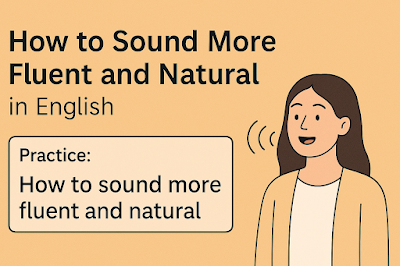Fluency in English isn’t just about speaking quickly—it’s about sounding smooth, natural, and confident. Many English learners struggle with sounding fluent, even if they know a lot of vocabulary and grammar. In this guide, you’ll learn how to improve your pronunciation and rhythm so that you sound more like a native speaker.
We’ll break down the phrase “How to sound more fluent and natural” as a practical example to help you master the techniques.
🔑 What Does It Mean to Sound Fluent and Natural?
-
Fluent: Speaking without too many pauses or hesitation.
-
Natural: Speaking with a rhythm, tone, and pronunciation that sounds like a native speaker.
Key Features of Fluent and Natural Speech:
-
Connected speech
-
Correct word and sentence stress
-
Reduced sounds
-
Smooth rhythm
-
Appropriate intonation
🧠 1. Understand the Rhythm of English
English is a stress-timed language, meaning some syllables are stressed more than others, while unstressed syllables are spoken quickly.
In our example:
🗣️ “How to sound more fluent and natural”
Listen to the natural rhythm:
➡️ HOW to SOUND more FLUent and NAtural
💡 Notice how the stressed syllables are pronounced clearly, and the unstressed words are quicker and softer.
🔗 2. Use Connected Speech
Connected speech means words blend together when spoken.
Example:
Instead of:
❌ How / to / sound / more / fluent / and / natural
Say: ✅ How-tuh sound more fluent’n natural
Here’s what’s happening:
-
“to” becomes “tuh” (a reduced sound)
-
“and” becomes “’n” (a quick, unstressed form)
🔊 3. Reduce Function Words
Function words (like “to,” “and,” “the,” etc.) are usually reduced or unstressed in fluent speech.
Practice:
-
to → /tə/ or /tʊ/
-
and → /ən/ or just a short 'n
Say it slowly:
🔸 How to sound more fluent and natural
Now try fluently: 🔹 How-tuh sound more fluent’n natural
📣 4. Practice Word Stress and Sentence Stress
Let’s break down our example phrase:
| Word | Stressed? | Notes |
|---|---|---|
| How | ✅ Yes | Wh-word, naturally stressed |
| to | ❌ No | Reduced to /tə/ |
| sound | ✅ Yes | Main verb, carries stress |
| more | ❌ No (light) | May carry light stress |
| fluent | ✅ Yes | 1st syllable stressed: FLUent |
| and | ❌ No | Reduced: /ən/ or 'n |
| natural | ✅ Yes | 1st syllable stressed: NATural |
🗣️ 5. Intonation and Flow
Speak in thought groups (chunks of meaning) and use falling or rising intonation naturally.
Thought Group Example:
[How to sound] [more fluent and natural]
🔉 Practice this line with rising-falling intonation:
“How to sound more fluent and natural.”
🎯 Practice Section
Use this step-by-step practice routine daily.
✅ Step 1: Listen and Repeat
Listen to this native-like pronunciation:
🔊 “How to sound more fluent and natural”
Now repeat:
-
Slowly: “How... to... sound... more... fluent... and... natural.”
-
Naturally: “How-tuh sound more fluent’n natural.”
✅ Step 2: Record Yourself
Use your phone or computer to record yourself saying:
“How to sound more fluent and natural.”
Then compare with a native speaker or model audio. Notice:
-
Are your stressed words clear?
-
Are you reducing “to” and “and”?
-
Is the flow smooth?
✅ Step 3: Shadowing Exercise
-
Find a recording of a native speaker saying the phrase.
-
Play it, then speak along with it at the same time—like an echo.
-
Repeat until your rhythm, stress, and pronunciation match.
📌 Final Tips for Sounding Fluent and Natural
-
Listen to English daily (podcasts, YouTube, etc.)
-
Mimic native speakers as often as possible
-
Learn common phrases as chunks (e.g., “How to sound like…”)
-
Don’t focus only on individual words—focus on the flow
🧭 Summary
✅ Fluency = Smooth + Natural + Confident
✅ Practice stress, connected speech, reductions, and rhythm
✅ Use real-life phrases like “How to sound more fluent and natural” for training
📥 Want More Practice?
Sign up for our free pronunciation mini-course and get:
-
Daily bite-sized audio lessons
-
Practice scripts and checklists
-
Feedback options to track your progress

Comments
Post a Comment